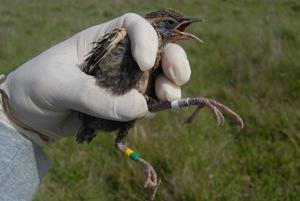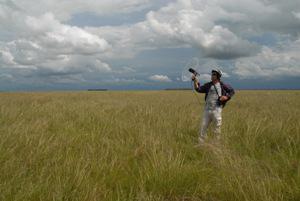Adrián Azpiroz
Other projects
29 Aug 2008
Pampas Meadowlark: Using a Flagship Species to Promote Conservation in the South American Grasslands I
9 Oct 2013
Pampas Meadowlark: Using a Flagship Species to Promote Conservation in South American Grasslands III
12 Aug 2015
Pampas Meadowlark: Using a Flagship Species to Promote Conservation in South American Grasslands IV
This project focuses on the Pampas Meadowlark, a globally threatened bird. Proposed activities will combine research (population monitoring, colour banding, habitat management) and outreach work to strengthen conservation outputs derived from previous phases of the project.

Meadowlark fledgling.
The proposed work will produce new biological data about the Pampas Meadowlark and other associated avifauna and will disseminate research results and conservation outcomes through various complementing approaches. Biological data is directly relevant to conservation because it provides the necessary information to identify sound species management actions. A strong outreach campaign will reinforce previous efforts focused on calling attention to Pampas birds conservation needs. Some of the expected outcomes are:

Meadowlark Song Recording.
1. Identification of Pampas Meadowlark population trends: A population-monitoring programme will be initiated using the Pampas Meadowlark Song Library as baseline data. Population trends will be identified.

Vera Town School.
2. Characterization of Pampas Meadowlark Seasonal Movements and Spatial Needs: Colour banding and territory mapping will broaden our understanding of these topics, which are particularly relevant to conservation.
3. Habitat Conservation: Habitat will be managed in at least two private ranches. Land management for the meadowlark will also benefit other grassland threatened species such as Ochre-breasted Pipit.
4. Increased Understanding of the Conservation Needs of Pampas Biodiversity: Large-scale dissemination of Pampas birds’ conservation issues through the internet and complementing education and outreach activities will generate additional support for the protection of the last areas of well-conserved natural grasslands in Northern Uruguay.
Almost the entire Pampas region has been altered by agricultural activities and this has resulted in major range contractions among obligate grassland birds such as the Pampas Meadowlark. The Arerunguá region of Northern Uruguay harbours some of the best examples of natural Pampas grasslands.
Unfortunately, amongst Pampas threatened species most are little known, and their ecological needs have not been identified. The Pampas Meadowlark Project will continue to produce key biological data that can be directly applied to conservation. In addition, public awareness and political will be further enhanced with the application of proven methods. In sum, my team and I will combine research and education tools to achieve long-terms conservation goals for the charismatic Pampas Meadowlark and other associated wildlife.